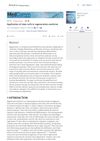Application of Stem Cells in Regenerative Medicine
June 2023
in “
MedComm
”
stem cells exosomes regenerative medicine skin healing bone healing tissue regeneration chronic wound treatment nanoformulations liposomes nanoliposomes polymer micelles microspheres hydrogels scaffold microneedles anti-inflammatory effects immunomodulatory effects mesenchymal stem cells MSCs wound healing nerve regeneration hair follicle regeneration nanotechnology drug delivery

TLDR Stem cells and their exosomes show promise for repairing tissues and healing wounds when delivered effectively, but more research is needed on their tracking and optimal use.
The document discusses the role of stem cells and their exosomes in regenerative medicine, particularly in skin and bone healing. Stem cells can self-replicate, differentiate, and modulate the immune system, aiding in tissue regeneration and chronic wound treatment. Stem cell exosomes share similar properties and play a crucial role in tissue regeneration and wound healing. The paper proposes the use of nanoformulations, liposomes, nanoliposomes, polymer micelles, microspheres, hydrogels, and scaffold microneedles to improve their delivery. The document also highlights the anti-inflammatory and immunomodulatory effects of mesenchymal stem cells (MSCs), which are crucial in the wound healing process. MSCs can migrate to the site of injury and differentiate into local components, aiding in tissue regeneration. The document also discusses the role of stem cells in nerve regeneration and hair follicle regeneration. The document also discusses the application of stem cells in regenerative medicine, focusing on their use in bone regeneration and skin regeneration through exosomes. The document also discusses the potential of combining stem cells and exosomes with nanotechnology for more precise and effective treatment. The document discusses the application of various nanoformulations in stem cell therapy and drug delivery. The document concludes that targeted transport of stem cells using these methods can effectively repair lesion sites and maintain stem cells. However, there are still many unanswered research questions, such as how to accurately track the growth of stem cells in the body, the number of cells needed for treatment, and whether stem cells remain in the lungs after whole-body transplantation.
















